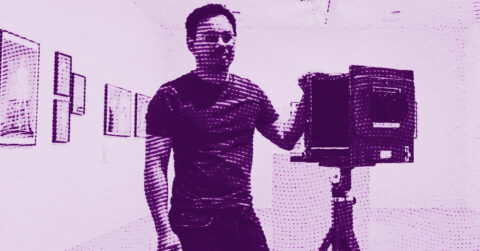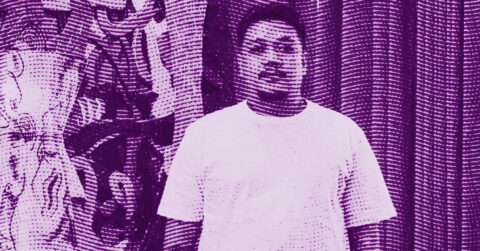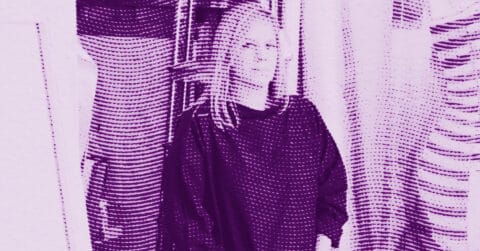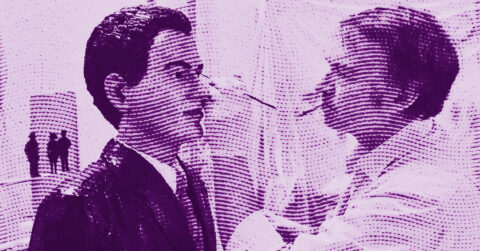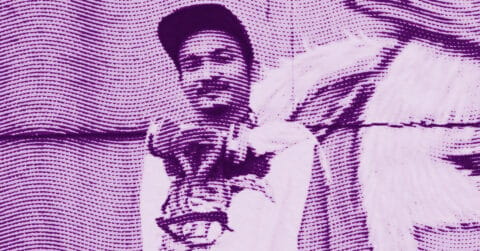Listen to me carefully, you bunch of snobs! Too bad for you if you haven’t discovered Qiu Xiaofei yet, this Chinese artist who stubbornly refuses to be confined within the stifling frameworks of conventional contemporary art. Born in 1977 in Harbin, a city in northeastern China that still bears the stigmas of Soviet influence, Qiu Xiaofei navigates between worlds with an ease that makes artists stuck in their monotonous style envious, like parrots repeating the same melody.
Seeing his works for the first time is a shock, as if someone decided to wake up a dreamer abruptly in the middle of a dream. Qiu’s canvases are not mere representations; they are portals to a space-time where past, present, and future intertwine in a cosmic dance. His painterly technique, both intuitive and deliberate, invites us to dive into the depths of collective consciousness, where our personal memories interweave with great History.
What sets Qiu Xiaofei apart from the pack of contemporary Chinese artists who have flooded Western galleries over the past decades is his ability to transcend labels. He is neither a simple nostalgic for bygone times, nor a harsh critic of the regime, nor a servile follower of Western artistic trends. He is all of this and much more. His work is a spiral, this form he loves so much, which coils upon itself while relentlessly moving forward.
Take, for example, his work ‘Trotskyky grew into a tree’ (2021), exhibited at his show at the New Century Art Foundation. The title alone is an intellectual provocation, a nod to the political history of China and Russia. But what is striking about this work is how Qiu transforms a political concept into an organic metaphor. The figure of Trotsky, this fallen revolutionary, erased from official photos by Stalin, is reincarnated as a tree, a symbol of permanence and growth. It is precisely this ability to metamorphose political history into a poetic vision that makes Qiu such an interesting artist.
The philosophy of Søren Kierkegaard resonates deeply in the work of Qiu Xiaofei. The Danish philosopher stated that ‘repetition and memory are the same movement, but in opposite directions; for what is remembered has been, is repeated backwards, while true repetition is recollected forwards’ [1]. This idea of a bidirectional movement of time is found in almost all of Qiu’s works, where temporal strata superimpose like geological layers. In ‘Red’ (2020), this impressive canvas dominated by crimson tones, Qiu perfectly illustrates this Kierkegaardian conception of time. The central figure, depicted in a heroic posture, seems suspended between past and future, while the red background pulses like a time vortex. Qiu does not merely illustrate the Danish philosopher’s thought; he reinterprets it through the prism of his personal experience and Chinese history.
Kierkegaard also wrote about existential anxiety, that dizzying sensation in the face of freedom and infinite possibilities. In ‘Apollo Bangs Dionysus,’ an exhibition presented at the Pace Gallery in Beijing in 2014, Qiu explores this tension between the Apollonian and the Dionysian, between rational order and creative intoxication. The exhibited works, characterized by splashes of vivid colors and ambiguous forms, manifest this inner struggle between structure and chaos. Qiu does not merely illustrate philosophical concepts; he lives them through his artistic practice, transforming the canvas into a battlefield where opposing forces clash.
The influence of literature on Qiu Xiaofei’s work is as significant as that of philosophy. His art often evokes the dreamlike universe of Jorge Luis Borges, that Argentine writer for whom time was a labyrinth with multiple branches. In his short story ‘The Garden of Forking Paths,’ Borges imagines a universe where all possible futures coexist simultaneously [2]. Similarly, Qiu creates works where diverse temporalities overlap, where past and future intertwine in an expanded present. His painting ‘Society Emissary’ (2020-2021) perfectly illustrates this Borgesian conception of time: a serpentine form coils upon itself under two human figures, evoking the multiple bifurcations of time and the possible futures that coexist within the same pictorial space.
Borges was fascinated by labyrinths, those architectural constructs where one can get lost endlessly. Qiu, on the other hand, is obsessed with spirals, those forms where one turns while moving away or closer to a center. In his recent canvases, this spiral becomes both a visual motif and an organizing principle. The works from his ‘BARE’ series, exhibited at Xavier Hufkens in Brussels in 2024, are structured like temporal spirals where each turn brings us back to a point similar but slightly different from the previous one. This is exactly what Borges described in ‘The Library of Babel’: an infinite universe where everything repeats with slight variations.
Borgesian literature and Qiu’s work also share this fascination with memory and its distortions. In ‘Funes the Memorious,’ Borges describes a man with a perfect memory, incapable of forgetting the slightest detail. Paradoxically, this absolute memory becomes a handicap, preventing Funes from thinking abstractly. Qiu constantly plays with this tension between remembering and forgetting. His early works, based on family photos and objects from his childhood, seemed to be exercises in remembrance. But upon closer inspection, one realizes that it is rather a reflection on the very nature of memory, on its gaps and reconstructions.
What is striking about Qiu Xiaofei’s artistic evolution is his ability to renew himself without ever betraying his fundamental obsessions. While so many contemporary artists content themselves with repeating the same winning formula to exhaustion, Qiu has never stopped exploring new approaches, new techniques, new conceptual territories. From his early figurative works inspired by family photos to the dynamic abstractions of his recent creations, one can trace a coherent but never linear path, a spiral, in fact.
This evolution is reminiscent of that of Gerhard Richter, that chameleon of contemporary painting who has navigated between figuration and abstraction with disconcerting freedom. Like Richter, Qiu refuses labels and categories. He can move from a figurative canvas loaded with historical references to an abstract explosion of colors and forms, without ever giving the impression of betraying himself. This stylistic fluidity is not a sign of inconsistency, but rather the manifestation of a conception of time and art as a perpetual flux.
Superficial critics, and there are many, might see in this stylistic diversity a lack of coherence. Nothing could be further from the truth. Qiu’s coherence does not reside in an immediately recognizable visual signature, but in a constant interrogation of the nature of time, memory, and history. Each new series of works is an attempt to answer these fundamental questions through a different pictorial language.
One of Qiu’s most remarkable qualities is his ability to integrate both Western and Eastern influences into a personal and original synthesis. Unlike many contemporary Chinese artists who adopt Western aesthetic codes to the detriment of their cultural heritage, or who, conversely, play the card of Chinese exoticism to seduce the Western market, Qiu manages to create an authentic dialogue between these two traditions. In his recent canvases, one can discern the influence of traditional Chinese painting, particularly in the treatment of space and the use of mineral pigments, but also that of American abstract expressionism, with its ample gestures and chromatic freedom.
This fusion of traditions is not a mere stylistic exercise or a marketing strategy; it reflects the reality of a generation of Chinese artists who grew up straddling two worlds. Born in 1977, Qiu experienced post-Maoist China in full transformation. His childhood in Harbin, a city marked by Russian architecture and culture, exposed him to multiple influences from a young age. Then his studies at the prestigious Central Academy of Fine Arts in Beijing familiarized him with both Chinese and Western artistic canons. This hybrid identity is reflected in his work, which refuses the simplistic dichotomies between East and West, tradition and innovation, past and present.
Qiu’s relationship with his Chinese heritage is particularly complex and nuanced. Unlike the previous generation of Chinese artists, who often used political symbols and Maoist icons as easily identifiable visual signs for the Western public, Qiu is more interested in the underlying structures of Chinese thought, its cyclical conception of time, its organic vision of the world. In his recent works, traditional Chinese landscapes are deconstructed and then reconfigured in a contemporary syntax. This is not superficial cultural appropriation, but a true reinvention of tradition.
Take, for example, ‘Debris of Eternity’ (2023), presented in the ‘BARE’ exhibition at Xavier Hufkens. This canvas, with its dark background and organic forms that seem to emerge from the darkness, evokes the mountainous landscapes of traditional Chinese painting. But Qiu does not merely reproduce these landscapes; he transforms them into cosmic visions where the mountains become living, pulsating, almost extraterrestrial entities. This is no longer a landscape to be contemplated, but an organism to be inhabited.
This ability to transform the familiar into the strange, the traditional into the avant-garde, is one of Qiu’s signatures. In ‘Drunken Moon’ (2023), also presented at Xavier Hufkens, he takes up the classical motif of the moon, so dear to Chinese poetry, but gives it a hallucinatory dimension, as if the nocturnal star were observed through the prism of intoxication or dream. The moon is no longer that symbol of permanence and purity celebrated by poets; it becomes an unstable, fluctuating celestial body, reflecting the uncertainties of our time.
Qiu Xiaofei’s art is not merely a meditation on time and memory; it is also a reflection on the very nature of painting in the digital age. At a time when images are produced, consumed, and forgotten at a dizzying speed, when virtual reality and artificial intelligence challenge our perception of the world, Qiu reaffirms the relevance of this millennial medium that is painting. But he does not do so out of nostalgia or conservatism; on the contrary, he exploits the unique possibilities of painting to create images that resist rapid consumption, that demand sustained attention, active contemplation from the viewer.
In a recent interview, Qiu stated: ‘I believe that paintings often reveal human fragility. Throughout history, the role of painting has gradually diminished due to scientific and technological advances, cinema, and photography. What remains relevant in the field of painting? Its relationship with humanity itself, marked by a changing nature, fears, and anxieties. Painting will always remain relevant because it is linked to human imperfections.’ [3] This statement perfectly sums up Qiu’s approach: far from considering the limitations of painting as handicaps, he makes them assets, means of exploring human vulnerability and imperfection in a world obsessed with performance and technological perfection.
What also distinguishes Qiu from many contemporary artists is his refusal of the spectacular and the immediately seductive. His works do not seek to dazzle the gallery with flashy visual effects or monumental dimensions (although some of his canvases are indeed large in size). They rather invite a contemplative experience, a gradual immersion in a complex and layered visual universe. Each canvas is like a microcosm, a world in itself that slowly reveals itself to the attentive viewer.
This contemplative quality is particularly evident in his ‘BARE’ series, whose title refers to a verse by the Ming poet Wang Zhideng: ‘Naked, I beat the drum with unbridled fervor, freeing my indomitable soul’ [4]. This image of a naked man beating the drum frenetically evokes a state of trance, of direct communion with the world, stripped of the artifices of civilization. The paintings in this series, with their textured surfaces, earthy colors, and organic forms, visually translate this altered state of consciousness, this direct and unmediated experience of the world.
But do not be fooled: despite their apparent spontaneity, Qiu’s works are the fruit of a rigorous and thoughtful creative process. Unlike Pollock’s action painting, where gesture takes precedence over reflection, Qiu’s work involves a constant back-and-forth between intuition and analysis, between abandon and control. As he explains himself: ‘In the past, I drew my inspirations from images of the real world, but now I focus more on creating things in an imaginary world. Recently, I have favored the use of canvases with dark backgrounds to sketch forms and extract images from these forms. The process of extracting the image from the dark background has something divine, and the image emerges like a phantom from afar.’ [5]
This metaphor of the image emerging from darkness like a phantom is particularly revealing of Qiu’s approach. His painting is not so much a creation ex nihilo as a revelation, a unveiling of latent forms and images. This process evokes the surrealist technique of frottage, where hidden textures are revealed by rubbing the pencil on the paper. But Qiu pushes this logic even further, transforming the canvas into a sensitive surface where not only visual forms are inscribed, but also memorial imprints, traces of collective and individual history.
This conception of painting as revelation rather than pure invention is not unlike Martin Heidegger’s thought on art. For the German philosopher, the work of art is not a simple representation of the world, but an ‘event of truth,’ a place where the being of things is unveiled. Qiu, without explicitly referring to Heidegger, seems to share this vision of art as unveiling. His paintings do not so much represent the world as they make it appear in a new light, revealing aspects of reality that usually remain hidden from our daily perception.
So the next time you find yourself in front of a work by Qiu Xiaofei, do not be content with a superficial and distracted glance. Take the time to immerse yourself in these canvases with multiple layers, to follow the meanders of these temporal spirals, to let yourself be carried away by these flows of colors and forms that tell a story much more complex and nuanced than what your lazy eye can grasp at first glance. For Qiu’s art is not made to be consumed quickly, but to be inhabited, lived, experienced over time. And perhaps then, you bunch of snobs, you will finally understand what it truly means to look at a painting.
- Kierkegaard, Søren, ‘Repetition,’ 1843, in Complete Works, Éditions de l’Orante, Paris, 1984.
- Borges, Jorge Luis, ‘The Garden of Forking Paths,’ in Fictions, Gallimard, Paris, 1951.
- Interview with Qiu Xiaofei by Carol Real, ‘Qiu Xiaofei: Painting the Infinite Loop of Time,’ Art Summit, June 7, 2024.
- Wang Zhideng, ‘First Day of the Wu Shen Year,’ 1608, translated by François Cheng in Chinese Poetry, Albin Michel, Paris, 2000.
- Interview with Qiu Xiaofei by Carol Real, ‘Qiu Xiaofei: Painting the Infinite Loop of Time,’ Art Summit, June 7, 2024.




